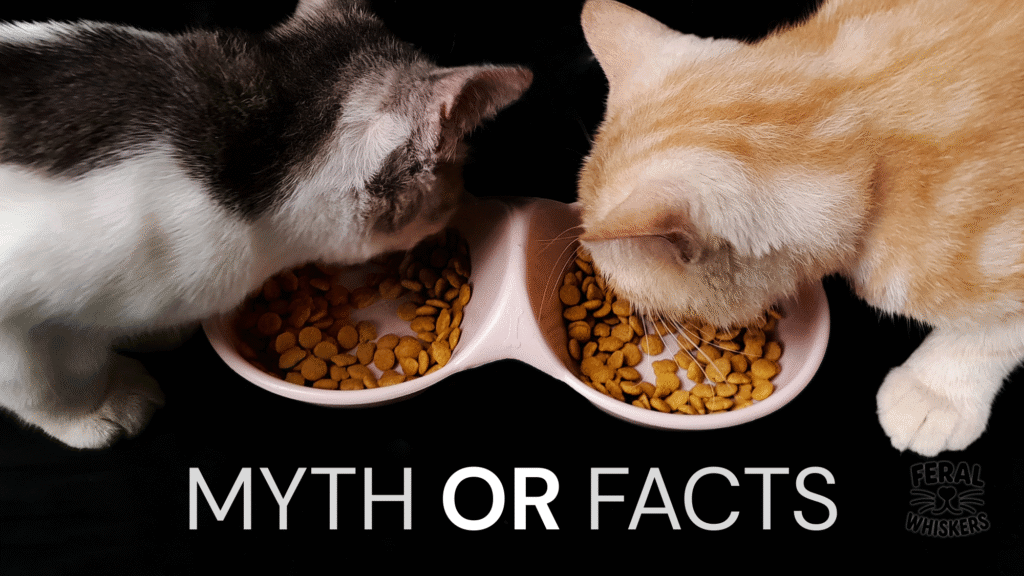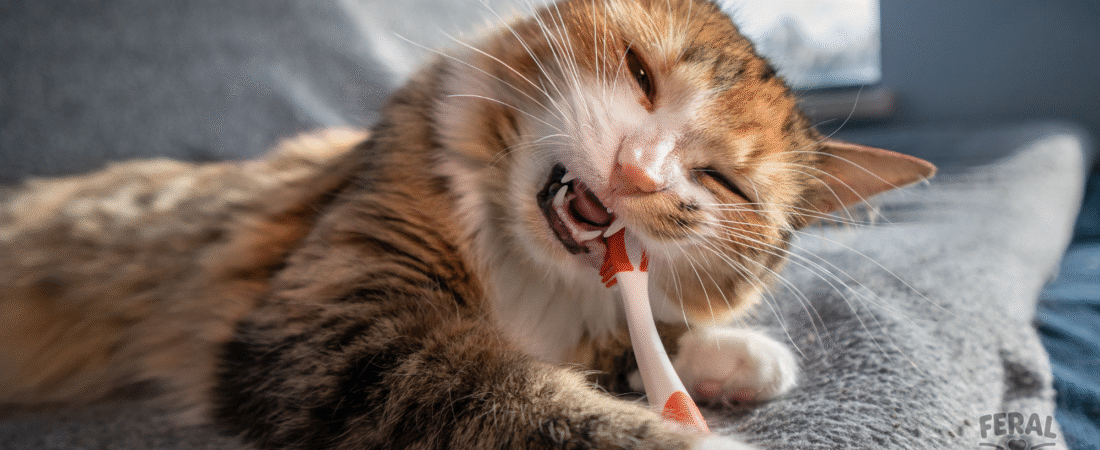
📌 Why Cat Food Myths Persist
The pet food industry is huge, and with so much information (and misinformation) out there, it’s easy to fall for common myths. These myths can lead to poor dietary choices, impacting your cat’s health.
👉 It’s time to separate fact from fiction to ensure your feline friend gets the best nutrition.
❌ Myth 1: Dry Kibble Cleans Cats’ Teeth
- The Myth: The crunchy texture of kibble scrapes plaque off teeth, preventing dental disease.
- The Truth: Kibble shatters on impact, offering minimal abrasive action. It’s like humans eating crackers to clean their teeth. In fact, the carbohydrates in kibble can stick to teeth, contributing to plaque buildup.
- What actually works: Regular brushing, dental treats approved by the Veterinary Oral Health Council (VOHC), and professional dental cleanings.
❌ Myth 2: Cats Need Grains in Their Diet
- The Myth: Grains (corn, wheat, rice) are essential for energy and digestion.
- The Truth: Cats are obligate carnivores. Their digestive systems are designed for meat, not grains. They lack the enzymes to efficiently process carbohydrates. While not toxic, grains are often used as cheap fillers, contributing to obesity and diabetes.
- What cats need: Animal-based protein and fat for energy.
❌ Myth 3: All By-Products Are Bad
- The Myth: “Meat by-products” are disgusting, low-quality fillers.
- The Truth: This is a nuanced one. By-products can be low-quality (feathers, hooves). However, they also include highly nutritious organ meats (liver, heart, kidney) which are biologically appropriate for cats and rich in vitamins and minerals.
- What to look for: Named by-products (e.g., “chicken liver”) are generally good. Unnamed “meat by-products” are a red flag.
❌ Myth 4: Cats Can Be Vegetarian or Vegan
- The Myth: A plant-based diet is healthier for cats, just like for humans.
- The Truth: Absolutely false and dangerous. Cats must eat meat. They require essential amino acids like taurine and arginine, and fatty acids like arachidonic acid, which are found only in animal tissues. Without these, cats develop severe, often fatal, health issues (blindness, heart failure, liver disease).
- What cats need: A diet composed primarily of animal protein.
❌ Myth 5: Fish is the Best Food for Cats
- The Myth: Cats love fish, so it must be good for them.
- The Truth: While cats enjoy fish, it shouldn’t be their primary diet.
- Mercury: High levels in some fish.
- Thiaminase: Raw fish contains an enzyme that destroys thiamine (Vitamin B1), leading to deficiency.
- Allergies: Fish is a common allergen for cats.
- What to do: Fish is fine as an occasional treat or as one protein in a rotational diet, but not as the sole protein source.
❌ Myth 6: Expensive Food is Always Better
- The Myth: The higher the price tag, the better the quality.
- The Truth: Price doesn’t always equal quality. Some expensive brands rely on clever marketing. Conversely, some affordable brands offer excellent nutrition.
- What to do: Read labels (AAFCO, ingredients, guaranteed analysis) to assess quality, not just price.
❌ Myth 7: Cats Need Milk
- The Myth: Cats love milk, so it’s a healthy treat.
- The Truth: Most adult cats are lactose intolerant. They lack the enzyme lactase to digest milk sugar. Giving milk can cause stomach upset, diarrhea, and vomiting.
- What to do: Offer fresh water. If you want a dairy treat, tiny amounts of plain, unsweetened goat kefir (which has beneficial probiotics) are better tolerated.
❌ Myth 8: Cats Should Free-Feed (Food Always Available)
- The Myth: Cats know how much to eat, so leave food out all day.
- The Truth: While some cats can self-regulate, many will overeat, leading to obesity. Free-feeding also makes it hard to monitor appetite (a key health indicator) and can attract pests.
- What to do: Scheduled meal times (2–3 times a day for adults) are generally better for weight management and health monitoring.
🌿 Holistic Perspective on Myths
Holistic nutrition emphasizes species-appropriate diets. Many myths stem from humanizing cat diets or prioritizing convenience over biology.
- Focus on: High-quality animal protein, moisture, and minimal processing.
- Avoid: Excessive carbs, artificial ingredients, and foods not biologically suited for cats.
❓ FAQs
Q1: Is grain-free kibble always healthy?
Not necessarily. Some grain-free kibbles replace grains with other high-carb fillers like potatoes or peas.
Q2: My cat loves milk, is it okay?
Even if they love it, it can cause digestive upset. It’s best to avoid it.
Q3: How can I tell if a food is truly high quality?
Check the AAFCO statement, ensure meat is the first ingredient, and review the guaranteed analysis for high protein/fat and low carbs.
💡 Final Thoughts
Don’t let common myths dictate your cat’s diet. By understanding the biological needs of an obligate carnivore and critically evaluating pet food claims, you can make informed choices that lead to a healthier, happier cat.
✅ Key takeaway: Always prioritize meat-based protein, moisture, and balanced nutrition over marketing hype or outdated beliefs.

